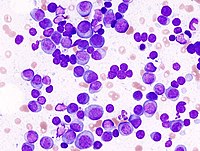
Photo from wikipedia
Multiple myeloma (MM) accounts for 10% of hematological cancers. Stem cell transplantation remains the cornerstone of first‐line treatment for eligible patients, but historically, pharmaceutical treatment options for MM have been… Click to show full abstract
Multiple myeloma (MM) accounts for 10% of hematological cancers. Stem cell transplantation remains the cornerstone of first‐line treatment for eligible patients, but historically, pharmaceutical treatment options for MM have been limited. The proteasome was identified as a target for MM therapy in the early 2000s and, in 2004, the boronic acid proteasome inhibitor bortezomib gained European approval. Bortezomib now plays a major role in MM treatment, but the duration of its use can be limited by toxicities such as peripheral neuropathy and the development of resistance. A new generation of proteasome inhibitors has since entered the treatment landscape: carfilzomib, an epoxyketone‐based agent with a distinct mode of action, high clinical efficacy, and lower levels of peripheral neuropathy compared with bortezomib, received approval in 2015 for use in patients with relapsed and/or refractory MM (RRMM). Ixazomib, a second‐generation, orally administered, boronic acid proteasome inhibitor, has also been approved for use in patients with RRMM. In just over a decade, proteasome inhibitor‐based regimens have become an integral component of MM treatment; with more proteasome inhibitors in development, this remains a vibrant research area with potential to improve the lives of patients with MM in the years to come.
Journal Title: European Journal of Haematology
Year Published: 2018
Link to full text (if available)
Share on Social Media: Sign Up to like & get
recommendations!